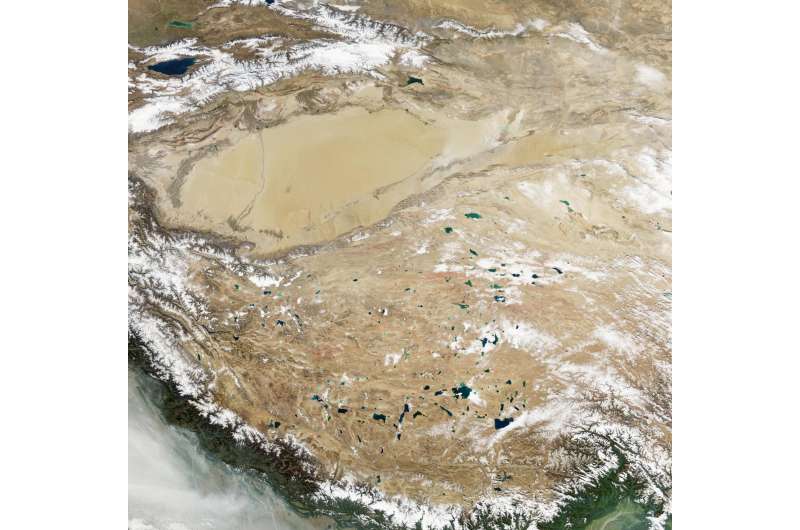May 9, 2017 report
Carbon uptake in Tibetan Plateau soil may offset melting permafrost carbon release

(Phys.org)—An international team of researchers has found that carbon uptake in the Tibetan Plateau may actually offset the carbon that is released as permafrost melts. In their paper published in the journal Nature Geoscience, the team describes soil readings they analyzed from the region and what their findings suggest about carbon release in cold parts of the world.
Anyone paying attention to the science surrounding global warming has heard about the problem of carbon released into the atmosphere due to permafrost melting in colder parts of the planet. Less well known or understood is what happens to the soil above the permafrost. As temperatures rise, soil above the permafrost becomes warmer, offering a haven for new plant growth—such plants have been found to sequester carbon from the air back into the soil. Thus, as more carbon is released from below, more is sequestered from above, but is it possible that new sequestering offsets old release? That is what the researchers with this new effort want to know. To learn more, they studied soil samples taken from multiple sites in the Tibetan Plateau (a large elevated plateau north of the Himalayas) in the early 2000s and compared them with similar samples taken a decade later.
The researchers report that the soil samples were taken from depths up to 30 cm (which is above the permafrost line) and found an average accumulation of carbon in the soil to have occurred at a mean rate of 28.0 g cm−2 yr−1, which they concluded was due to accumulation of organic carbon concentrations (material left when plants died). They describe the increase as substantial, and possibly enough to offset carbon released due to permafrost melting. More tests will have to be conducted to determine if there is a true offset, but the study results suggest that climate change models might have to be adjusted if offsetting occurs in regions much farther north. If carbon released by melting permafrost in Russia, Canada and other parts of the world is offset by new plant growth, it is possible that much less carbon will make its way into the atmosphere than has been predicted, resulting in slower than predicted global warming.
More information: Jinzhi Ding et al. Decadal soil carbon accumulation across Tibetan permafrost regions, Nature Geoscience (2017). DOI: 10.1038/ngeo2945
Abstract
Permafrost soils store large amounts of carbon. Warming can result in carbon release from thawing permafrost, but it can also lead to enhanced primary production, which can increase soil carbon stocks. The balance of these fluxes determines the nature of the permafrost feedback to warming. Here we assessed decadal changes in soil organic carbon stocks in the active layer—the uppermost 30 cm—of permafrost soils across Tibetan alpine regions, based on repeated soil carbon measurements in the early 2000s and 2010s at the same sites. We observed an overall accumulation of soil organic carbon irrespective of vegetation type, with a mean rate of 28.0 g C m−2 yr−1 across Tibetan permafrost regions. This soil organic carbon accrual occurred only in the subsurface soil, between depths of 10 and 30 cm, mainly induced by an increase of soil organic carbon concentrations. We conclude that the upper active layer of Tibetan alpine permafrost currently represents a substantial regional soil carbon sink in a warming climate, implying that carbon losses of deeper and older permafrost carbon might be offset by increases in upper-active-layer soil organic carbon stocks, which probably results from enhanced vegetation growth.
Journal information: Nature Geoscience
© 2017 Phys.org





















